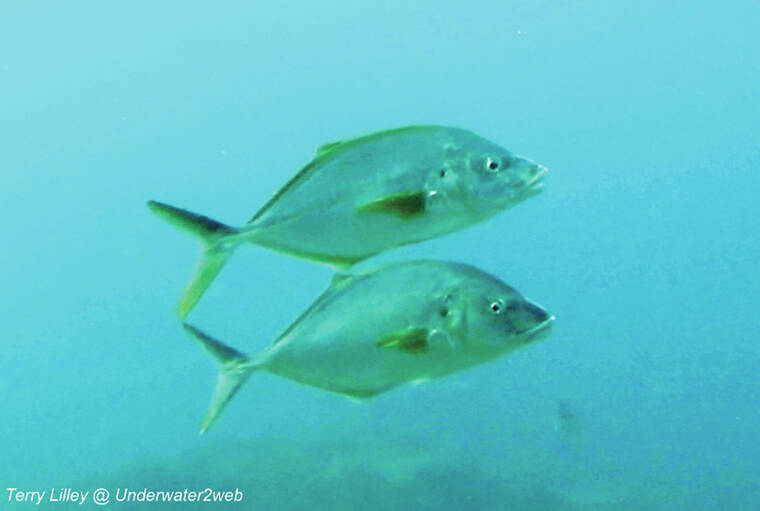CRITTER: Lehe the Hawaiian thicklipped jack
Fishermen here in Hawai‘i like to catch the giant trevally (ulua) or a large bluefin trevally (omilu), as these are the two most common large game fish that live on our shallow near shore reefs. Occasionally, while fishing over the sand, people catch the smaller barred jack, which is also called ulua. The juveniles of all three of these species are papio, and when they are small it is hard to tell them apart.
When I scuba dive along the remote Kaua‘i North Shore, I often see all three of these large jack species on a single hourlong dive and some are over 100 pounds. Ni‘ihau and Kaua‘i seem to have more of the larger jacks than any other one of the main Hawaiian Islands, but up in the Northwest Hawaiian Islands they are even more common along with other jack species we rarely see here at home in Kaua‘i. The water is much cooler in the NW Islands and many fish species prefer the colder water.
Recently, I was diving at about 60 feet deep on the outer reef at Wainiha along North Shore doing a coral study, when I noticed some very large fish coming my way out of the deep blue. At first I thought they were a school of giant ulua, but as they got closer they looked really strange and I realized that they were a fish species I have never seen before. So I shot a quick video clip of them passing by.
There were eight of these 30-inch long, silver-colored fish in the school and they did one circle around me diving, then took off back into the deep. I was excited to get back home and look at the footage to try and identify these strange looking fish that looked similar to a giant ulua, but more streamline with giant lips.
It turns out the fish I saw that day in Wainiha a half mile offshore were lehe the Hawaiian thicklip jacks. The only pictures I have seen of this rare and elusive jack were from Midway Atoll, which is thousands of miles away.
Seeing them in Kaua‘i was quite a treat and it also shows the fish that live in the Northwest Hawaiian Islands do venture down to Kaua‘i from time to time. DNA studies have shown that Kaua‘i and Ni‘ihau marine life species are directly related to the Northwest Hawaiian Island species and not the main Hawaiian Island species. Even the corals in Kaua‘i are related to the corals 1,000 miles away in the Northwest Hawaiian Islands and not the corals from nearby O‘ahu.
There are deep water trenches off of Kaua‘i that upwell cool nutrient rich water, which brings in the cooler water species and along North Shore is an integrated zone where you can find the cold water species like the thicklipped jack and the more warm water species like the yellow tangs.
The North Shore is still unexplored and no telling what might be lurking offshore in the cooler deep waters. We will soon be using underwater drone submarines along North Shore that go to 400 feet deep and it will be exciting to see what we find.
I am currently producing a movie showing how different marine life is on Kaua‘i and Ni‘ihau versus the rest of the Hawaiian Islands, and as soon as it is done it will be posted up on my marine science educational YouTube channel at Underwater2web.com.
•••
Terry Lilley is a marine biologist living in Hanalei Kaua‘i and co-founder of Reef Guardians Hawai‘i, a nonprofit on a mission to provide education and resources to protect the coral reef. To donate to Reef Guardians Hawaii go to www.reefguardianshawaii.org.

